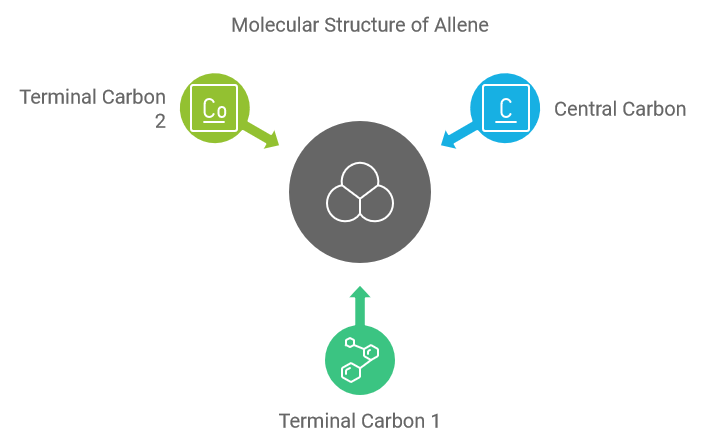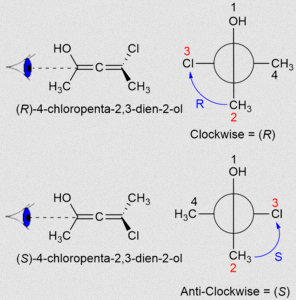Allene, also known as propadiene, is a type of organic compound characterized by its unique structure and chemical properties. Its systematic name is 1,2-propadiene, reflecting its molecular composition. The chemical formula of allene is C₃H₄, and it features a linear arrangement of three carbon atoms with two adjacent double bonds, specifically CH₂=C=C=CH₂.
In the vast world of organic chemistry, understanding the nuances of different chemical compounds is crucial. Each compound has unique properties and applications that contribute to the broader field of science and industry. One such compound is allene, a fascinating molecule with distinct characteristics that make it an important subject of study.

What is Allene?
Allene is an organic compound that is notable for its unique structure and chemical behavior. It is systematically known as 1,2-propadiene, which reflects its molecular arrangement. Commonly, it is referred to as propadiene. The chemical formula for allene is C₃H₄, and its structure features a linear arrangement of three carbon atoms with two adjacent double bonds, specifically arranged as CH₂=C=C=CH₂. This configuration imparts specific properties and reactivity to allene, distinguishing it from other hydrocarbons.
Chemical Structure and Properties
- Structure: Allene’s molecular structure is distinguished by its linear arrangement of three carbon atoms. In this configuration, the central carbon is double-bonded to both terminal carbon atoms. This results in a unique geometry where the central carbon atom is sp-hybridized, while the terminal carbons are sp²-hybridized. This arrangement leads to a distinct spatial orientation of the double bonds.
- Bonding: The two double bonds in allene are conjugated, meaning they are separated by a single carbon-carbon single bond. This conjugation affects the molecule’s electronic structure, contributing to its reactivity and stability. Conjugated systems can influence the molecule’s absorption of light and chemical reactivity, making allene a valuable intermediate in various reactions.
- Appearance: In its pure form, allene is a colorless gas with a slightly sweet odor. Its reactivity is attributed to its structure, which makes it a useful compound in organic synthesis. The gas is highly reactive and must be handled carefully to prevent unwanted reactions.
Significance in Chemistry
Allene plays a crucial role in organic synthesis due to its unique chemical properties. Its structure allows it to participate in various reactions, making it a valuable building block for more complex organic molecules. In chemical processes, allene is used in the production of polymers, pharmaceuticals, and other specialized compounds. Its distinct characteristics make it an important compound for researchers and industrial chemists alike, providing versatility and utility in diverse chemical applications.
Resources
For further reading and to validate the information about allene, the following resources provide comprehensive details:
- Chemistry LibreTexts – Allene (Propadiene): This resource offers an in-depth look at allene’s chemical properties and structure. [Chemistry LibreTexts](https://chemistry.libretexts.org/Bookshelves/Organic_Chemistry/Organic_Chemistry_1_(Alder) /08%3A_Hydrocarbons/8.04%3A_Alkenes_and_Dienes/8.4B%3A_Conjugated_Dienes)
- PubChem – Allene: A detailed entry on allene, including its chemical properties, structure, and safety information. PubChem
- Royal Society of Chemistry – Allene: Provides scientific insights and data on allene, including its applications and significance. RSC
Conclusion
In summary, allene, also known as propadiene, is a unique organic compound with a distinctive structure that plays a significant role in organic chemistry. Its linear arrangement of carbon atoms and conjugated double bonds make it a valuable intermediate in various chemical reactions. Understanding its properties and applications is crucial for both academic research and industrial processes. Allene’s versatility in organic synthesis underscores its importance, offering opportunities for the development of new materials and compounds.
FAQ
1. What is the systematic name of allene?
Allene’s systematic name is 1,2-propadiene. It is commonly known as propadiene in simpler terms.
2. What is the molecular formula of allene?
The molecular formula of allene is C₃H₄.
3. How is the structure of allene arranged?
Allene has a linear arrangement of three carbon atoms with two adjacent double bonds. The central carbon atom is sp-hybridized, while the terminal carbon atoms are sp²-hybridized.
4. What is the significance of conjugated double bonds in allene?
The conjugated double bonds in allene affect its reactivity and stability. Conjugation can influence the molecule’s electronic properties, including its light absorption and chemical reactivity.
5. What does allene look like in its pure form?
In its pure form, allene is a colorless gas with a slightly sweet odor. Due to its high reactivity, it needs to be handled carefully.
6. How is allene used in organic synthesis?
Allene is a valuable building block in organic synthesis. Its unique structure allows it to participate in various chemical reactions, making it important in the production of polymers, pharmaceuticals, and other specialized compounds.
7. Why is allene important in research and industry?
Allene’s distinct chemical properties make it a crucial compound for both research and industrial applications. Its versatility in organic synthesis allows for the development of new materials and compounds, making it valuable in numerous chemical processes.
8. Where can I find more information about allene?
For more detailed information about allene, you can refer to the following resources:
- Chemistry LibreTexts – Allene (Propadiene) /08%3A_Hydrocarbons/8.04%3A_Alkenes_and_Dienes/8.4B%3A_Conjugated_Dienes)
- PubChem – Allene
- Royal Society of Chemistry – Allene
